|
THE BOX OFFENSE
When looking for an offense that can either get your
team into a set play or any other offense, one of the most effective
ways to accomplish this is to run the box offense. The box offense
has been used by many teams through the years and is capable of taking
advantage of a team that runs effective three-around-two offense whether
it is a set offense or a free-lance offense.
Advantages of the Box Offense
The first advantage of the box offense is that it is relatively easy to teach.
Just about every set offense is simple to teach, but this one takes it to a new
level. The box offense has pre-sets and sets that can be learned quickly
and many variations that players can figure out fast.
Second, the box offense allows for post ups and post entry throughout the
entirety of the offense. The pre-sets and the sets are designed to get the
ball into the post. This helps the offense score more points because those
teams that are able to get post penetration are more likely to score and less
likely to come away with empty possessions.
Finally, the box offense runs many of the offensive maneuvers a team will see
during the course of the season. By having exposure to the variety of
maneuvers that a team will face on defense, teams that run the box offense will
be prepared for the season ahead. This is because when teams scrimmage
with the box offense, they see the offensive maneuvers on a daily basis so
nothing that opposing teams in games run will be anything new or different..
Disadvantages of the Box Offense
One major disadvantage of the box offense is that it can
become predictable. The way in which this offense can become
predictable is that since it is normally a set-play offense, other teams
can easily scout the offense. Those teams that can figure out the
offense have the best chance of stopping it.
Another disadvantage of the box offense is that it
requires a particular type of personnel. The personnel required is
a three-around-two type personnel. This means that three players
must be perimeter-type players while the other two players will
primarily play in the post.
Box Offense Pre-Sets
In the box offense, we will run four pre-sets that will
all have the same look at the start. The point guard will have the
ball in the middle of the floor while #'s 2 and 3 start on the low
blocks and #'s 4 and 5 start at the elbows (Diagram 1).
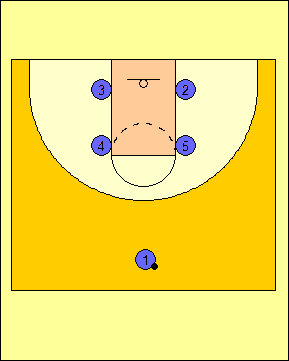
Diagram
1 |
The first pre-set shown is called "Pop". Here,
#'s 2 and 3 will pop to the wings on their respective sides and look
to get the basketball. This pre-set favors the wings as far as
their getting the basketball is concerned.
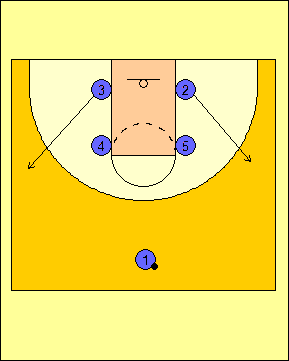
Diagram
2 |
The second pre-set is called "Down" and, like "Pop", is
designed to get the ball into the hands of our wing players. #'s 4
and 5 will set down screens for #'s 3 and 2 respectively as they cut to
the wings on their respective sides (Diagram 3). After the cutters
come off of their screens, #'s 4 and 5 will come high to the elbows on
their respective sides and look to get the basketball.
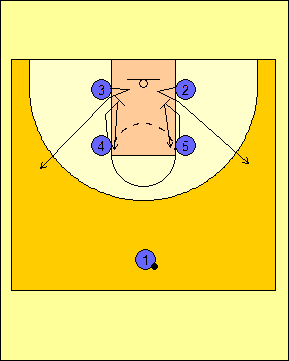
Diagram
3 |
The third pre-set that we run is called "Cross".
Like the two previous pre-sets, the pre-set is designed to get the
wings open to receive the basketball. When the pre-set is
called, #'s 2 and 3 will cross low and come off of down screens set
by #'s 4 and 5 respectively (Diagram 4). Once the wings have
come off of the screens, #'s 4 and 5 will come high to the elbows on
their respective sides.
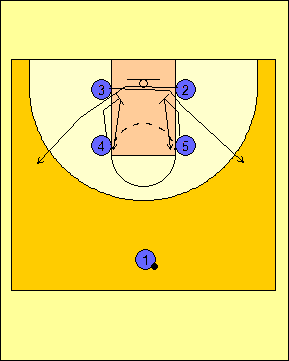
Diagram
4 |
Finally, the last pre-set that I will show is geared
towards the big men and is called "Kentucky". Here, #'s 2 and
#3 will rub off of the big men on their respective sides in an
effort to get them open (Diagram 5). The rub must be between
the man and the ball and it is designed to clear away any man
defending the big men. The cut off of the big men will result
in the wing players coming to the wings on their starting sides.

Diagram
5 |
Box Offense into 1-4 High Offense
All of the pre-sets for the set plays out of the box
offense are run from a 1-4 high set (Diagram 6). We have the
posts set up just below the free throw line-extended and the wings
above the free throw line-extended. This set up is designed to
give us a better chance of getting back doors should we enter the
ball into the high post.

Diagram
6 |
Post Entry
The main play in the box offense has a variety of
ways to run the offense. The first entry is to hit the post
with a pass (Diagram 7). Whenever we pass the ball to the high
post, we look to hit the backdoor cut first.

Diagram
7 |
If the backdoor is not open, we continue the play.
The cutter will come off of a down screen by the help-side post as
shown in Diagram 8. The post can pass to either the cutter in
the corner or hit the screener on the high-low duck-in.

Diagram
8 |
When the ball is passed to the corner, the ball can
then be passed into the low post (Diagram 9).
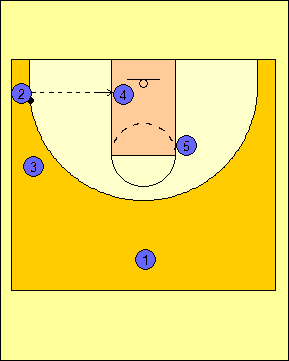
Diagram
9 |
Should those passes not be available, the other wing
cuts through the middle of the lane looking for the ball (Diagram
10). If he does not receive the ball, he will go through to
the ball-side corner. Meanwhile, the point guard spots up at
the help-side slot and gets in the sight of the post.

Diagram
10 |
Wing Option
Another option that we have is the entry pass to the
wing. Because most of our entries favor entry to the wing,
this is the most-frequently run play in the box offense. When
the ball is entered to the wing, the ball-side post drops to the low
post while the help-side post sets a back screen for the point guard
(Diagram 11). The wing can pass to either the post or the
cutter off of the back screen.

Diagram
11 |
If neither pass is available, the player setting the
screen in the high post steps out and receives the ball from the
wing (Diagram 12). His first look is to hit the other post on
the high-low duck-in.

Diagram
12 |
If the ball cannot be passed, we have a pressure
release that can be executed. The wing dribbles at the high
post and forces the backdoor (Diagram 13). If the backdoor is
not there, the pass is made to the opposite wing.
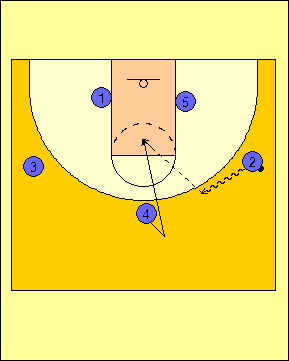
Diagram
13 |
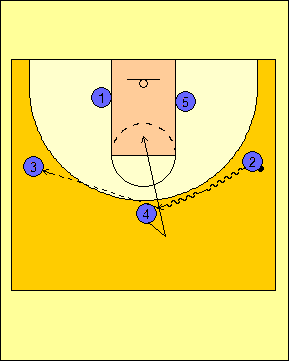
Diagram
14 |
If the pass is made to the high post from the wing,
we will work a back screen with the wing and the point guard
(Diagram 15). We can either hit the cutter off of the back
screen or hit the screener coming to the wing.
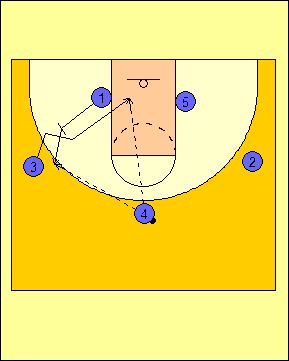
Diagram
15 |
If the pass cannot be made, we will run a pressure
release. The player screening and popping to the wing will cut
backdoor and the player who came off of the back screen will work up
the lane line before popping to the wing (Diagram 16). We will
run this pressure release until someone comes open.
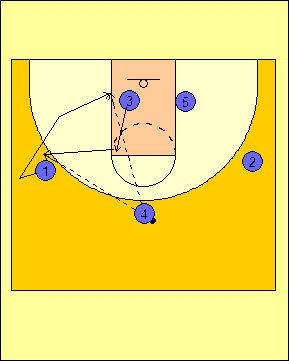
Diagram
16 |
Once the ball has been reversed from wing to wing,
we will run screen the screener action (Diagram 17). The wing
will screen away for the low post and the high post will set a down
screen for the wing.
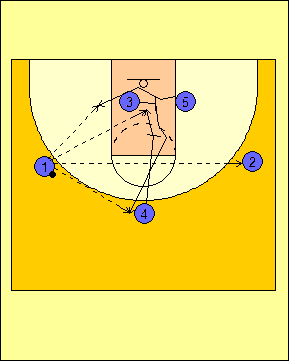
Diagram
17 |
Once we have completed running the play, we will get
back into a three-around-two look (Diagram 18). From here, we
can bring the posts high and try to run the post option or get into
another offense.

Diagram
18 |
Dribble Entry
Another way to get into the offense off of the
pre-set is the use of the dribble entry. This is typically run
if we cannot enter the basketball to either the wing or the post on
the pass. Here, the point guard dribbles out the wing and
looks to set up a possible backdoor (Diagram 19). If the
backdoor is not open, the point guard must keep his dribble alive.
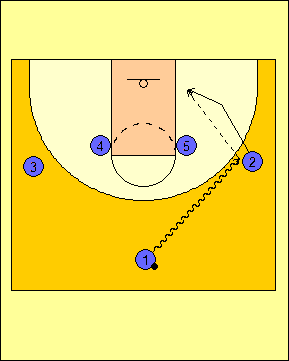
Diagram
19 |
Diagram 20 shows what can happen if the backdoor is
not available. The ball-side post rolls to the ball-side low
post and the help-side post steps across his man and comes to the
high post. From here, the offense is run the same as if we
were running the wing option which is detailed in Diagrams 21-23.
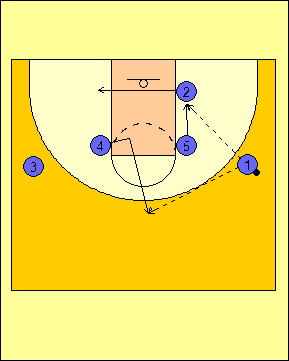
Diagram
20 |

Diagram
21 |
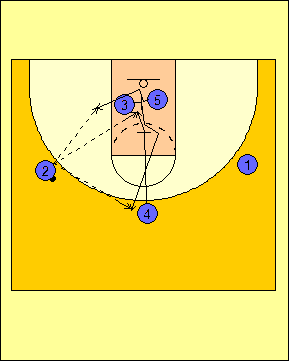
Diagram
22 |

Diagram
23 |
Box Offense Audibles
To keep the defense off balance with our set offense
from the box offense, we oftentimes use variations of the offense so
that we can run other plays and take better advantage of our
personnel. The set offense as presented earlier is an auto for
us. We will call audibles to take advantage of our personnel
and we have counters for whatever the defense tries to take away.
Here are a couple of those audibles.
The first audible is called "Pinch". Here, the
play starts similar to the post entry that is run as the main play
in the box offense with the backdoor off of post entry (Diagram 24)
and the down screen for the cutter with the duck-in (Diagram 25).
However, unlike the main play, there is a throw over to the
help-side wing can also be made.

Diagram
24 |
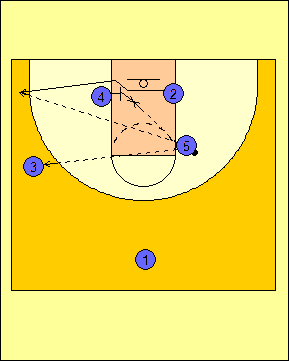
Diagram
25 |
When running the pinch post, we will look to hand
the ball off to the point guard from the high post (Diagram 26).
The point guard will look to shoot or attack the rim off the
dribble.

Diagram
26 |
If we are unsuccessful in getting the handoff
(Diagram 27), the point guard will pop back to the ball-side wing
and look to receive the pass back from the high post (Diagram 28).
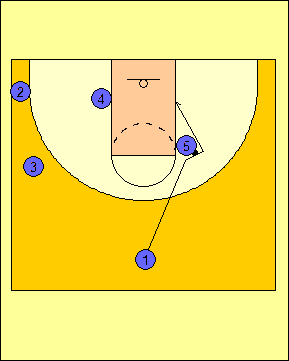
Diagram
27 |
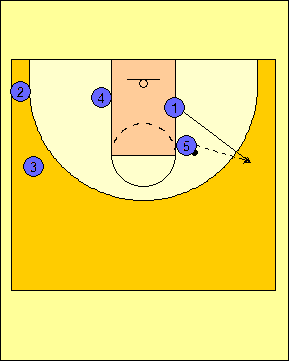
Diagram
28 |
If the ball is thrown back to the wing off of the
pinch post play, we will run a side pick-and-roll (Diagram 29).
The player who started as the help-side wing comes up to the
help-side slot before the ball screen is set. The point guard
has several attack options with the ability to drive to the basket
and/or dump the ball off to the other four players.
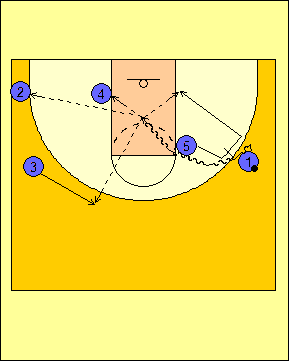
Diagram
29 |
"Gator"
In lieu of the wing option, we will run an audible
called "Gator". The play starts with the point guard making a
pass to the wing and cutting to the ball-side corner (Diagram 30).
The ball-side post will set a screen for the help-side post who will
come over the top looking for the ball from the wing. The
help-side wing will move to the help-side low post area.

Diagram
30 |
If we are unable to enter the ball to the low post,
we will pass to the high post (Diagram 31). The help-side wing
will pop back to the wing on his side and look to receive the
reversal from the high post.
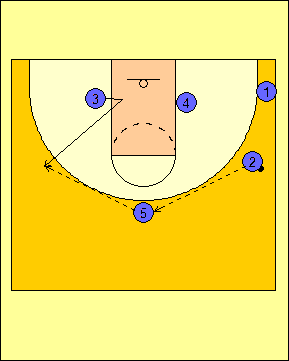
Diagram
31 |
Once the reversal is completed, the low post will set a back screen
for the wing opposite the ball (Diagram 32). We will look to hit
the cutter making the shuffle cut.

Diagram 32 |
If the shuffle cut is not open, the play continues
with two actions as shown in Diagram 33. The first of these is
that the player who set the back screen will flash to the ball-side
high post. The other is that the post player in the high post
will set a down screen for the player in the corner opposite the
ball.

Diagram 33 |
After #1 comes off of the down screen set by #5, #5
will set a down screen for #2 (Diagram 34). If the ball is
swung to #1, he can pass the ball to #2 at the wing or hit #5 on the
slip.

Diagram 34 |
"Gator" Counters
When we run "Gator", there will be moments where
we cannot execute certain parts of the play. When this
happens we have a number of counters that we can execute.
The first of these is the dive option somewhat similar to what
happens in the basic box offense play (Diagram 35). When
we run the dive option, we are looking to hit the high post on
the backdoor.
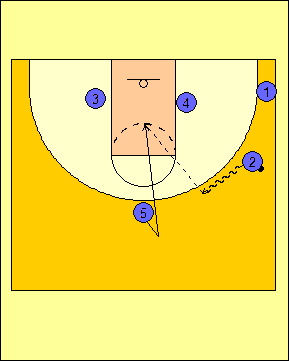
Diagram 35 |
If we are unsuccessful in hitting the backdoor, the
help-side wing will pop to the wing position on his side and receive
the pass from the player dribbling on the dive counter (Diagram 36).
Once he receives the ball, the high post player replaces the low
post who will then side a side ball screen (Diagram 37).
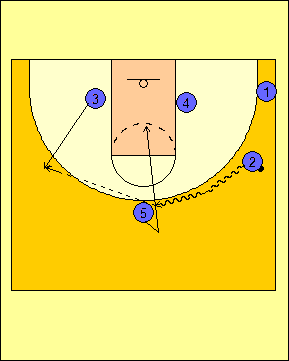
Diagram 36 |
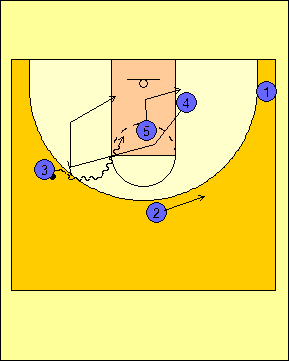
Diagram 37 |
If we are not able to make the pass from the point
man to the feeder in "Gator", we will look to hit the feeder for a
backdoor by faking high then cutting backdoor (Diagram 38). If
that pass is not available, the player starting as the ball-side
wing will set a down screen for the player in the corner for a jump
shot (Diagram 39).

Diagram 38 |

Diagram 39 |
Dribble Option from "Gator"
The second of the two options to enter into "Gator"
is the dribble option. It is run the same way as the dribble
entry into the main set play in the box offense. In Diagram
40, the point guard dribbles to the wing and forces the backdoor to
come open. If that is not there, the ball-side post will
screen away for the help-side post, the help-side wing will go to
the help-side low post, and the ball-side wing will cut to the
ball-side corner (Diagram 41).
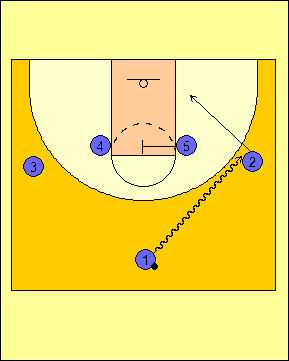
Diagram
40 |
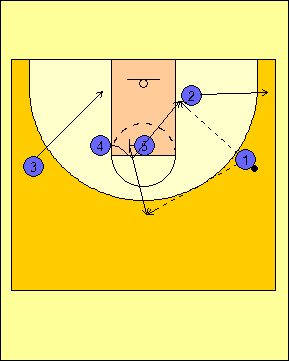
Diagram
41 |
From this point, the rest of "Gator" can be run. Diagrams 42-45
illustrate the remainder of "Gator" with all of the action shown and
described earlier in the article.

Diagram
42 |
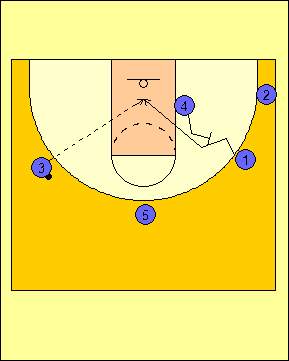
Diagram
43 |

Diagram
44 |

Diagram
45 |
Quick Hitters from the Box Set
If we decide that we do not want to run a set
offense or a pre-set within the box offense, we can use this
opportunity to run some quick-hitting plays. All of these
plays are designed to get our best players shots within the set.
The first play is called "Strong" (Diagram 46).
On this play, #1 will pick a side and dribble to the wing while #2
sets a cross screen for #3. Coming off of the cross screen, #3
will look to post up on the ball-side low block while #2 will come
off of a double-down screen set by #'s 4 and 5.
The complimentary play to this is called "Weak"
(Diagram 47). We will have the same dribble-entry action
looking to post up #2 instead of #3. Because we post #2, #3
will come through the double-down screen.

Diagram
46 |

Diagram
47 |
The next quick hitter is called "Flare" and can go
either way. Here, #1 will pass to either post and the opposite
post will set a flare screen (Diagram 48). On the entry, the
wing player on that side will pop to the ball-side corner to clear
out for the rest of the action on the play.
If the post is able to get the ball back to the
point guard off of the flare screen, we will run screen-the-screener
action with the remaining wing player setting a back screen for the
post player who received the post entry pass from the point guard
before receiving a down screen from the player who set the flare
screen (Diagram 49).

Diagram
48 |

Diagram
49 |
The last quick hitter I will present is a play from
Larry Brown called "Winner". The play runs in two parts and
can result in a three-point shot or an immediate post-up for an easy
two.
In Diagram 50, the point guard will dribble the ball
to a side and get a high ball screen from either post. The
post who does not set the ball screen will come off of a stagger
double set by #'s 2 and 3 and look for the post entry pass from #1.
Should the post entry pass not be available, #'s 4
and 5 will set down screens for #'s 2 and 3 respectively (Diagram
51). Here, we will look for the three point shot in the corner
or at the top of the key. We can also pass to the posts
slipping to the basket after setting the down screens if the defense
switches.

Diagram
50 |
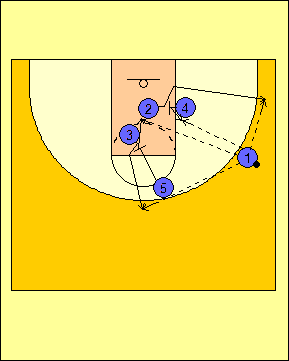
Diagram 51 |
Teaching the Box Offense
When teaching the box offense, it is always best to
teach the offense whole method. Breakdown drills can always be
incorporated, but it is always best to start with teaching the
offense five-on-zero before doing any breakdown drills or running
the offense against a live defense. Only when the whole
offense is mastered should there be any exposure to a live defense
or any breakdown drills teaching parts of the offense.
RETURN TO MEMBERSHIP AREA
© 2010-2017 Alan Peel Enterprises
|